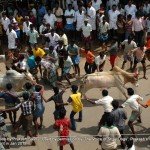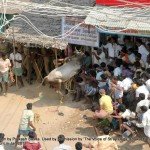Jallikattu: An event of barbaric animal cruelty.
Report – 1
by Prakash Sasha
Jan 2012
Introduction:
Various rules, regulations & law about Jallikattu were formed in the recent years. Primary focus of all these governing rules, law etc was about regulating the arena were the bull faces the matadors.
This report apart from discussing cruelty in the arena, brings to light some other key stages were unimaginable animal cruelty exits in Jallikattu and is ignored.
Photos from three Jallikattu events (Avaniapuram 15th Jan 2012, Alanganallur 17th Jan 2012 and Palamedu 16th Jan 2012) which convey cruelty at various stages are presented in this report.
Stages of Jallikattu:
- Stage-1: Hundreds of bulls stand in squeezed queue to enter the arena
- Stage-2: Animals enter in to the arena using the enclosed entry gate called Vaadi Vasal
- Stage-3: Arena where the bulls face the matadors
- Stage-4: Arena end point where the bulls are chased by owners of bull and the public
Ignored Cruelty in Stage – 1: Bull waiting in queue to enter arena:
- The number of bulls registered for each Jallikattu event goes to several hundred ( between 400 to 500 bulls) causing a complete chaos in the waiting area with several animals squeezed for space The animals stand in such packed queues in blistering heat for several hours the whole day without fodder or water.
- The nose rope is continuously dragged to control the bull which leads pain and bleeding wounds.
- Many animals are forced to walk for several kilo meters till the place where the event is conducted and then immediately dumped in the queue.
Ignored Cruelty in Stage – 2: Bull entry point in to the arena:
- Cruelty level increase manifold in this point which is an enclosed area where only one bull can stand and it’s a one way mode. Once bulls enter this enclosure then they cannot return back as the gates are closed.
- Bulls on seeing the crowd of matadors refuse to enter the arena and try to return back to the waiting area. Bulls are brutally hit with sticks and with hand to force them in to the arena
- Their tails are squeezed and bent to force them in to the arena
- Even police men are involved in this process of hitting the animal at entry point (or) they stand as mere spectators without taking any action on violators of the law.
Cruelty in Stage – 3: Arena:
- Bulls are controlled by too many matadors jumping on them
- Bulls neck is twisted
- Bulls head is thrashed on the floor
- Injured bulls are forced to participate in Jallikattu
- Bulls without horns are forced to participate
- Some short & tiny breeds of bulls that cannot resist the mob of matadors are forced to participate.
- Weak dehydrated bulls are forced to participate
Ignored Cruelty in Stage – 4: End Point (after crossing the arena):
- Bulls are chased by owners as well as public on un-fenced roads
- Huge mob of public beat the animal when it runs for its life
- Crowd screams in high volume increasing the fear of the animal
- There is no clear guiding path for the bull to follow and settle down
- All the above points results in animal hitting vehicles on the road , falling down on the rough tar road , jumping in to crowd to escape, falling from a high raised platform, hitting the barricades. While running accidentally hitting and injuring adults as well as children standing on the road.
Problems related to infrastructure and venue
Avaniapuram (Madurai District) :
- This place is NOT suitable for conducting Jallikattu as it is part of crowded city with houses and shops jam packed.
- There is no proper area where the bull can settle down after crossing the arena
- This venue is high risk zone as the bull is forced to run in the crowded street of the city leading to injury to general public as well as bulls
- Multiple roads branch at this end point leading to confusion among bulls on which way to run for their life, finally bulls end up falling, hitting barricades, shops , vehicles, people etc.
Palamedu (Madurai District):
- Police personnel sit in a tractor inside arena near the entry point leading to serious danger to animal as the bulls hit the tractor ( please refer the sketch )
- A concrete lamp post is very close to the entry point which poses a huge danger to animals that run & jump to escape from matadors
- The end point after arena has three roads branching which in turn confuses the animal and leads to animal running and falling on the road.
- There is an open river bed without fencing leading to animals jumping from an 8 foot wall in to the river bed to escape.
Alanganallur (Madurai District):
- The entry point and the running path are at 90 degree angle leading to a confusion for the bull on which way to run and finally bull hits the fence opposite to the entry point
- Police personnel sit in a tractor inside arena near the entry point leading to serious danger to animal as the bulls hit the tractor.
Conclusion:
- The animal cruelty depicted in this report is only a minor sample. If anyone visits the place where the actual Jallikattu event happens they will definitely realize the cruelty is 100 times more than what is presented here.
- Jallikattu is an event which involves several hundreds of bulls and thousands of people that cannot be regulated (or) controlled in any manner.
- Any form of law or rules or regulation are not enforced in the field level and the mob is uncontrollable at the field
- The complexity of the event is so high that bringing in any positive change by providing certain guidelines or rules finally will be in vain (as it is witnessed for the past few years)
- We pray that the honorable court considering all the facts presented in this report, bring in a complete BAN on this cruel Jallikattu that puts people as well as animals life in to risk and subjects animals to enormous cruelty violating the “Prevention of Cruelty to Animals Act”.
- Cruelty Stage 1: Waiting Area: Palamedu: Hundreds of bulls squeezed in queue for several hours in hot sun without fodder or water, with nose rope dragged hardly by the owners inflicting pain and bloody wounds.
- Cruelty Stage 2: Entry Point: Alanganallur: A tiny bull fearing to enter the arena seeing the huge mob of matadors
- Cruelty Stage 2: Entry Point: Palamedu: Bull with injured eye dragged in to entry point
- Cruelty Stage 2: Entry Point: Palamedu: Once the entry point back door is closed there is no other option for the bull than being trapped and face the huge mob of matadors
- Cruelty Stage 2: Entry Point: Palamedu: A bull which was never exposed to Jallikattu out of fear turns back and tries to escape thru the small gap in the metal gate
- Cruelty Stage 2: Entry Point: Palamedu: The same bull out of fear turns back breaks the metal gate and tries to escape. A man with green shirt attacks the animal with a stick with group of police being mere spectators
- Cruelty Stage 2: Entry Point: Palamedu: The same bull pounces in to the queue of waiting bulls creating a complete havoc among all bulls
- Cruelty Stage 2: Entry Point: Palamedu: The same bull tries to escape by breaking the barricade. A man is dragging its tail. Finally this animal was forced in to the arena.
- Cruelty Stage 2: Entry Point: Palamedu: A bull dragged in to arena with force
- Cruelty Stage 2: Entry Point: Avaniapuram: A bullâs tail twisted by its owner to force the animal in to the arena
- Cruelty Stage 2: Entry Point: Avaniapuram: A bull due to fear of facing the mob jumps back on the red color door and tries to escape (photo shot in top view)
- Cruelty Stage 3: Arena: Avaniapuram: Bull’s left horn broken in Jallikattu
- Cruelty Stage 3: Arena: Avaniapuram: Bull made to fall with head down position by twisting its neck on the floor
- Cruelty Stage 3: Arena: Avaniapuram: Bull head thrashed on the floor by twisting its neck
- Cruelty Stage 3: Arena: Avaniapuram: Bull with injured ears was forced in to the arena
- Cruelty Stage 3: Arena: Alanganallur: Matadorsâ jumping on the bull even before the bull enters the arena
- Cruelty Stage 3: Arena: Alanganallur: Tiny breeds of bull that are weak and which cannot fight against the mob are also forced to participate
- Cruelty Stage 3: Arena: Alanganallur: Bulls head thrashed on the floor
- Cruelty Stage 3: Arena: Alanganallur: Why hundreds of matadors for a single bull? Is this an event of valor?
- Cruelty Stage 3: Arena: Alanganallur: Infrastructure problem: Having a tractor inside the arena for police to sit which led to bulls hitting the tractor and getting injured
- Cruelty Stage 3: Arena: Alanganallur: Tail pulling even though banned is still done and these matadors are not removed from the arena
- Cruelty Stage 3: Arena: Alanganallur: Steel cupboards and cots are given as gift and even before these items are carried away from the arena bulls are let inside the arena
- Cruelty Stage 4: End Point: Avaniapuram: Bull running in full speed as the crowd screams & attacks the bull in an unfenced area on the crowded road with shops and houses on both sides.
- Cruelty Stage 4: End Point: Avaniapuram: Bull running to avoid the chasing crowd hits the ambulance which is parked blocking the way where the bulls run.
- Cruelty Stage 4: End Point: Avaniapuram: Bull running to avoid the chasing crowd hits the vehicles parked on road.
- Cruelty Stage 4: End Point: Avaniapuram: To avoid the mob standing on the bulls path, bull pounces in to the crowd trying to find a way to escape
- Cruelty Stage 4: End Point: Avaniapuram: Bull not knowing which way to escape jumps on the barricade and returns to the arena
- Cruelty Stage 4: End Point: Palamedu: Bull jumping in full speed in to the empty river bed from an 8 feet wall to avoid the chasing mob





































